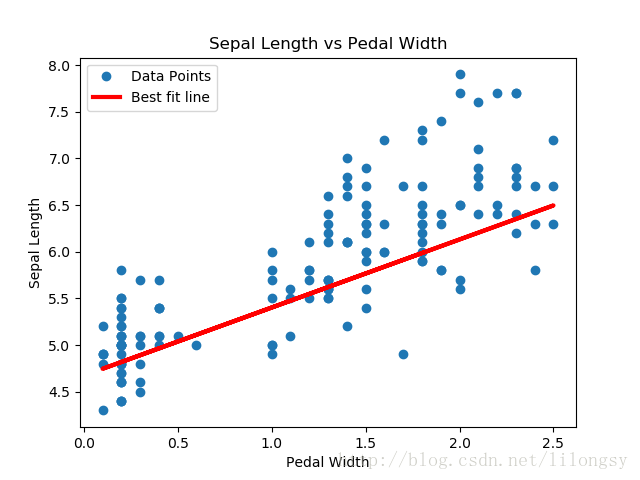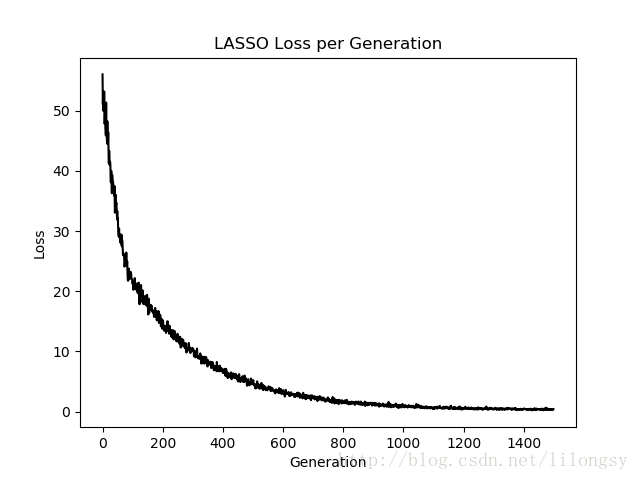也有些正则方法可以限制回归算法输出结果中系数的影响,其中最常用的两种正则方法是lasso回归和岭回归。
lasso回归和岭回归算法跟常规线性回归算法极其相似,有一点不同的是,在公式中增加正则项来限制斜率(或者净斜率)。这样做的主要原因是限制特征对因变量的影响,通过增加一个依赖斜率A的损失函数实现。
对于lasso回归算法,在损失函数上增加一项:斜率A的某个给定倍数。我们使用TensorFlow的逻辑操作,但没有这些操作相关的梯度,而是使用阶跃函数的连续估计,也称作连续阶跃函数,其会在截止点跳跃扩大。一会就可以看到如何使用lasso回归算法。
对于岭回归算法,增加一个L2范数,即斜率系数的L2正则。
|
1
2
3
4
5
6
7
8
9
10
11
12
13
14
15
16
17
18
19
20
21
22
23
24
25
26
27
28
29
30
31
32
33
34
35
36
37
38
39
40
41
42
43
44
45
46
47
48
49
50
51
52
53
54
55
56
57
58
59
60
61
62
63
64
65
66
67
68
69
70
71
72
73
74
75
76
77
78
79
80
81
82
83
84
85
86
87
88
89
90
91
92
93
94
95
96
97
98
99
100
101
102
103
104
105
106
107
108
109
110
111
112
113
114
115
116
117
118
119
120
121
122
123
124
125
126
127
128
129
130
131
132
133
134
135
136
137
138
139
140
141
142
143
144
145
146
147
148
149
150
151
152
|
# LASSO and Ridge Regression# lasso回归和岭回归# # This function shows how to use TensorFlow to solve LASSO or # Ridge regression for # y = Ax + b# # We will use the iris data, specifically: # y = Sepal Length # x = Petal Width# import required librariesimport matplotlib.pyplot as pltimport sysimport numpy as npimport tensorflow as tffrom sklearn import datasetsfrom tensorflow.python.framework import ops# Specify 'Ridge' or 'LASSO'regression_type = 'LASSO'# clear out old graphops.reset_default_graph()# Create graphsess = tf.Session()#### Load iris data#### iris.data = [(Sepal Length, Sepal Width, Petal Length, Petal Width)]iris = datasets.load_iris()x_vals = np.array([x[3] for x in iris.data])y_vals = np.array([y[0] for y in iris.data])#### Model Parameters#### Declare batch sizebatch_size = 50# Initialize placeholdersx_data = tf.placeholder(shape=[None, 1], dtype=tf.float32)y_target = tf.placeholder(shape=[None, 1], dtype=tf.float32)# make results reproducibleseed = 13np.random.seed(seed)tf.set_random_seed(seed)# Create variables for linear regressionA = tf.Variable(tf.random_normal(shape=[1,1]))b = tf.Variable(tf.random_normal(shape=[1,1]))# Declare model operationsmodel_output = tf.add(tf.matmul(x_data, A), b)#### Loss Functions#### Select appropriate loss function based on regression typeif regression_type == 'LASSO': # Declare Lasso loss function # 增加损失函数,其为改良过的连续阶跃函数,lasso回归的截止点设为0.9。 # 这意味着限制斜率系数不超过0.9 # Lasso Loss = L2_Loss + heavyside_step, # Where heavyside_step ~ 0 if A < constant, otherwise ~ 99 lasso_param = tf.constant(0.9) heavyside_step = tf.truediv(1., tf.add(1., tf.exp(tf.multiply(-50., tf.subtract(A, lasso_param))))) regularization_param = tf.multiply(heavyside_step, 99.) loss = tf.add(tf.reduce_mean(tf.square(y_target - model_output)), regularization_param)elif regression_type == 'Ridge': # Declare the Ridge loss function # Ridge loss = L2_loss + L2 norm of slope ridge_param = tf.constant(1.) ridge_loss = tf.reduce_mean(tf.square(A)) loss = tf.expand_dims(tf.add(tf.reduce_mean(tf.square(y_target - model_output)), tf.multiply(ridge_param, ridge_loss)), 0)else: print('Invalid regression_type parameter value',file=sys.stderr)#### Optimizer#### Declare optimizermy_opt = tf.train.GradientDescentOptimizer(0.001)train_step = my_opt.minimize(loss)#### Run regression#### Initialize variablesinit = tf.global_variables_initializer()sess.run(init)# Training looploss_vec = []for i in range(1500): rand_index = np.random.choice(len(x_vals), size=batch_size) rand_x = np.transpose([x_vals[rand_index]]) rand_y = np.transpose([y_vals[rand_index]]) sess.run(train_step, feed_dict={x_data: rand_x, y_target: rand_y}) temp_loss = sess.run(loss, feed_dict={x_data: rand_x, y_target: rand_y}) loss_vec.append(temp_loss[0]) if (i+1)%300==0: print('Step #' + str(i+1) + ' A = ' + str(sess.run(A)) + ' b = ' + str(sess.run(b))) print('Loss = ' + str(temp_loss)) print('\n')#### Extract regression results#### Get the optimal coefficients[slope] = sess.run(A)[y_intercept] = sess.run(b)# Get best fit linebest_fit = []for i in x_vals: best_fit.append(slope*i+y_intercept)#### Plot results#### Plot regression line against data pointsplt.plot(x_vals, y_vals, 'o', label='Data Points')plt.plot(x_vals, best_fit, 'r-', label='Best fit line', linewidth=3)plt.legend(loc='upper left')plt.title('Sepal Length vs Pedal Width')plt.xlabel('Pedal Width')plt.ylabel('Sepal Length')plt.show()# Plot loss over timeplt.plot(loss_vec, 'k-')plt.title(regression_type + ' Loss per Generation')plt.xlabel('Generation')plt.ylabel('Loss')plt.show() |
输出结果:
Step #300 A = [[ 0.77170753]] b = [[ 1.82499862]]
Loss = [[ 10.26473045]]
Step #600 A = [[ 0.75908542]] b = [[ 3.2220633]]
Loss = [[ 3.06292033]]
Step #900 A = [[ 0.74843585]] b = [[ 3.9975822]]
Loss = [[ 1.23220456]]
Step #1200 A = [[ 0.73752165]] b = [[ 4.42974091]]
Loss = [[ 0.57872057]]
Step #1500 A = [[ 0.72942668]] b = [[ 4.67253113]]
Loss = [[ 0.40874988]]


通过在标准线性回归估计的基础上,增加一个连续的阶跃函数,实现lasso回归算法。由于阶跃函数的坡度,我们需要注意步长,因为太大的步长会导致最终不收敛。
以上就是本文的全部内容,希望对大家的学习有所帮助,也希望大家多多支持服务器之家。
原文链接:https://blog.csdn.net/lilongsy/article/details/79363396










